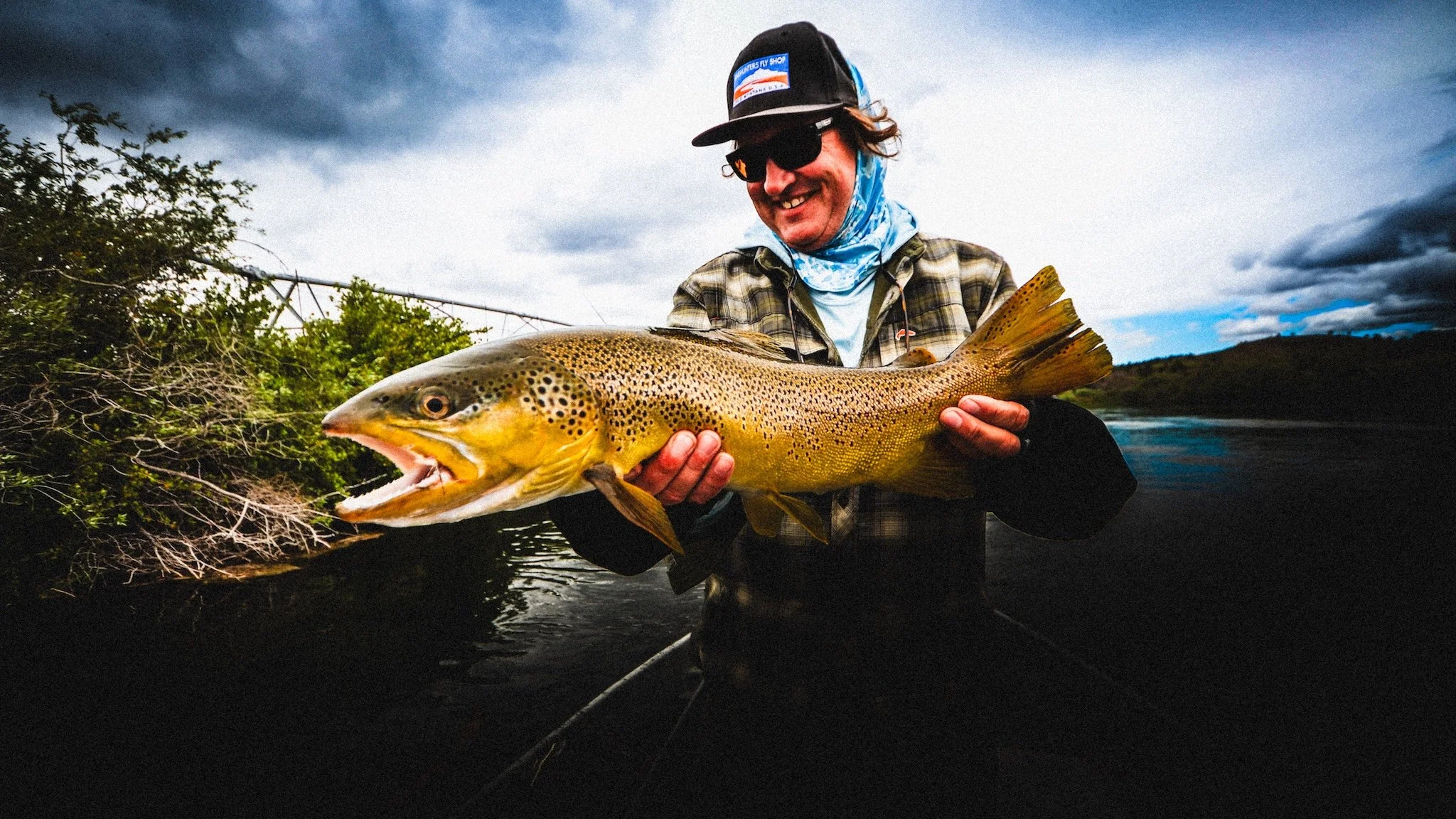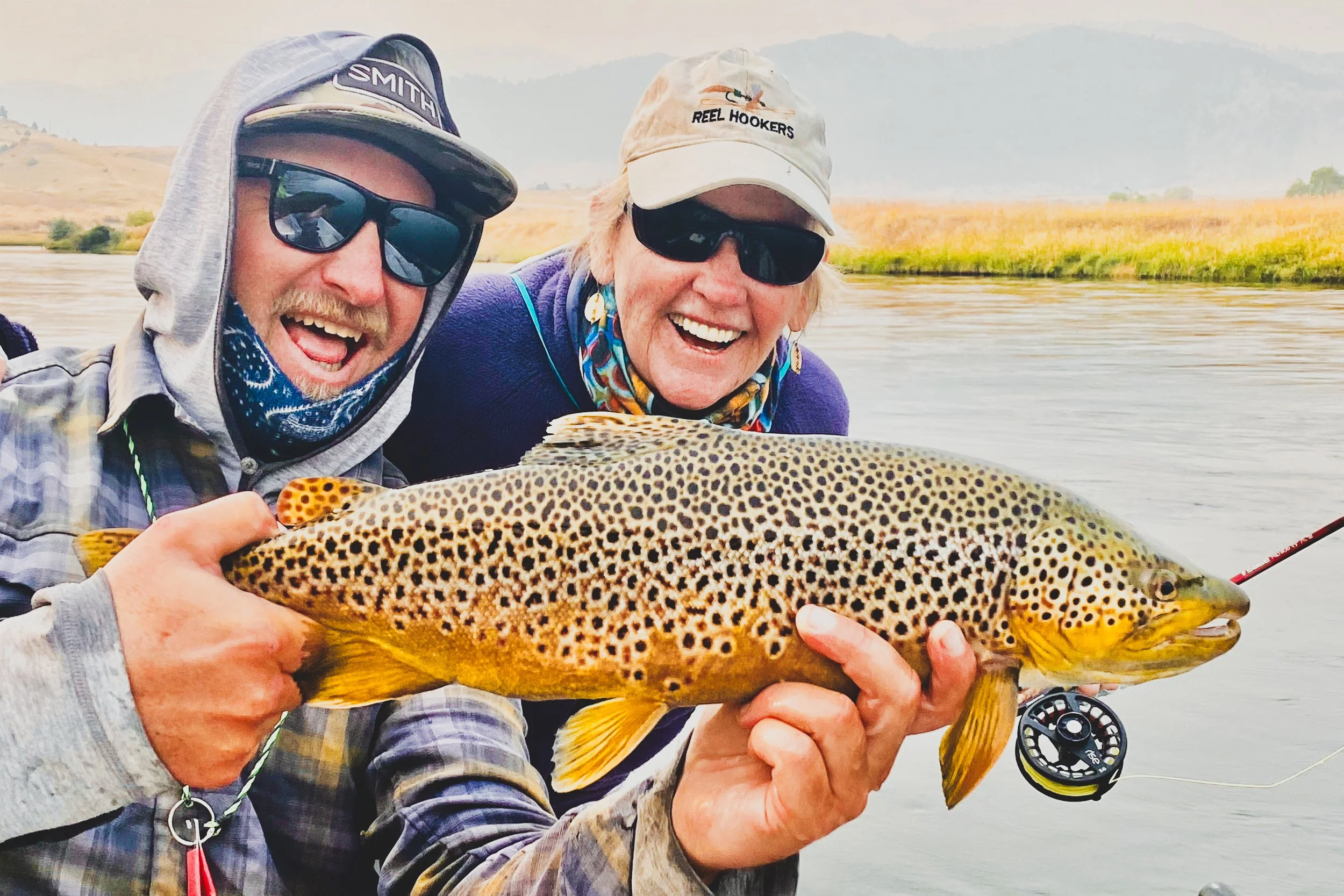
Behind a rising rainbow on the ‘Mo. Not the best position to be in.
MISSOURI RIVER
the
Recognized by anglers worldwide, the Missouri River below Holter Dam is considered one of North America’s best technical dry fly fisheries. If you like New York’s Delaware, or Idaho’s Henry’s Fork, you’ll love our stretch of the Missouri River. Mayflies and Caddis emerge, fly and die, almost everyday from late-April through early November. And you can usually find a few surface feeders eating midges during the winter months as well. And if “match the hatch” fishing isn’t your thing, both nymph and streamer fishing are excellent as well. In fact many anglers would identify the Missouri as one of the best nymph fishing venues in Montana. In recent years, we’ve popularized spey fishing for trout, and the Missouri is a never-ending stream of great swing runs. To top it off, you have Craig, Montana as the epicenter. Here you’ll find a culture that revolves around fly fishing. It’s not uncommon to run into an old fishing buddy, or one of those famous anglers from the magazines, while enjoying a post-fishing beverage in Craiglandia.
It’s All About the Hatches
INTRO | We’re often asked, “What’s the best trout stream in Montana?”. It’s an absurd question. There is no “best” trout stream in Montana. What defines a favorite river will be different for every angler. And while each may have his or her “favorite”, we think few would argue that the Missouri River is the “most consistent” fishery in Montana. It has consistent fish size and numbers, consistent hatches and predictable flows. It has the most reliable dry fly fishing in the region, and there’s not a day of the year when a nymph rig won’t catch a few fish. It’s a river that consistently produces large trout; arguably the largest “average size” trout in Montana. Dry fly, nymph and streamer fishing are almost always in play, and there is a reason the Missouri is the “Trout Spey” center of the West. The Missouri River is a world class fishery, and most experienced anglers consider it a “must-do” at least once in your life.
WHERE | The longest river system in the US, the Missouri, is formed at the junction of the Madison, Gallatin and Jefferson rivers near Three Forks, Montana. From here, the river flows north for nearly 100 miles - and through 4 reservoirs - before emerging from the tailwaters of Holter Dam. The Missouri River courses for over 700 miles through Montana and on to the Gulf of Mexico, but the primary fly fishing venue is the 35 miles from Holter Dam to the town of Cascade. This section lies between the cities of Helena and Great Falls, and runs alongside Interstate 15. Trout can still be found below Cascade, but numbers quickly decrease, as does access.
PHYSICAL | Long, broad and slow moving runs are interrupted by mellow riffles and numerous islands as the river slides gently from Holter Dam to Craig. The river here is big - 100 yards across - and is characterized by grassy banks with a bottom of fine gravel that bright green weed beds anchor in. It lacks definition here, and is hard to read for newcomers. Below Craig, the river enters “the Canyon”, where huge limestone cliffs and rock formations provide incredible scenery for anglers and deep, shady lies for trout. The Dearborn River also joins the Missouri in this reach, adding volume to the river, along with an increased diversity in insect life. The river is more defined through here, with sharper banks, defined drop-offs and the occasional mid-river boulder. The Canyon ends under the dramatic “Tower Rock” at Lone Pine rapids, a significant campsite of the Lewis & Clark Expedition. From here, the river broadens and slows as it spills out onto the Great Plains of eastern Montana. This lower section offers great big sky views, abundant wildlife, and exceptional dry fly water as it meanders to the small town of Cascade. The many channels and islands are extremely wadeable, and the trout often hold in shallow and slow moving water.
THE FISH | The Missouri River is primarily a Rainbow and Brown Trout fishery, with the former outnumbering the latter about 3:1. Both species inhabit all stretches of the river in pretty much equal numbers, though average sizes for both seem slightly larger on the upper stretch. Montana does not plant trout in rivers (they do in some lakes) so all of our trout are wild, and they act like it. Rainbow trout average 14-20”, and seldom exceed 22”. Brown trout are slightly larger averaging 16-22”, and it’s not surprising to land a “2-footer”, sometimes larger. While we don’t like to use the traditional “fish-per-mile” numbers that Montana Fish, Wildlife & Parks likes to publish, let’s just say that there are plenty of trout in the Missouri River. Native Whitefish also inhabit the Missouri, though they are not as numerous - and much larger - than found in most other Montana rivers. Trout are by far the primary quarry, but fly and spin anglers also hunt for Walleye, Burbot, Carp, and more recently, Northern Pike.
WHEN | The Missouri River is fishable all year long, but the primary fly fishing season is from April through November. During this period, the river sees some of the strongest Mayfly and Caddis hatches in the western U.S. These hatches begin in late March and come to a crescendo in late-June and early-July . As the summer progresses, hatches slowly subside, but are replaced with ample tererrestrital insects including hoppers and ants. Angler numbers can be tied to hatch strength, and July is not only the buggiest month, but the busiest. While mid-summer traditionally offers the best dry fly fishing, hatches occur from mid-April to mid-November on an almost daily basis. And when the hatches aren’t epic, the subsurface nymph and streamer fishing often is. So there’s really no “best” time to fish the Missouri, but there can be best times for certain disciplines.
TACTICS | You’ll often hear that the Missouri River is a”technical” fishery, and it can be. It can also be so easy it’s embarrassing, and it can be so tough you’d bet your new drift boat that there are no fish in it. All methods do catch fish here, and fishing is done both from drift boats and on foot. Many consider it a “tailwater” fishery, but it doesn’t quite share the same characteristics with true tailwaters and has a bit of moody freestone DNA. Nymphing is the most popular method, as it seems to have become nearly everywhere. A simple right-angle nymph rig is common, and knowing the right depth is key. Understanding what the fish are feeding on - and why - is critical to success. Dry fly fishing is technical, requiring long leaders, accurate casts, and correct imitations. Downstream dry fly fishing is the norm. Streamer fishing runs the gamut, but locals tend to use smaller streamers that imitate baitfish, crawdads, and other real food sources. The “4th Method”, spey fishing uses both Skagit and Scandi techniques and equipment, while swinging everything form #16 soft hackles to # 2 articulated streamers.
Headhunters lead guide Brett Matula with a happy customer.
GUIDED FLY FISHING TRIPS
If you’ve never fly fished the Missouri River before, it would be hard to argue against hiring a guide. And for those that like to fish on their own, hiring a guide for a day or two art the beginning of your trip is a great idea. It’ll get you wired in much quicker, both in terms of productive fly patterns, and with where the fish are. The Missouri is big and hard to read. Once you understand where the fish are holding, it can be much easier. This is especially true when nymph fishing, and even mores during high-water in early summer.
Our guide staff are all super-pro and accustomed to taking all kinds of anglers, from rank beginners to some of the best anglers in the world. They will share some tips with you to take out to the river on your own if you plan on DIY fishing for a few days. Always let your guide know what your goals are for the day, and you’re certain to have great one.
-
You’ll likely be nymphing deep in slow water with midge patterns and ‘pink stuff’. Streamer fishing and swinging flies can be decent, but fridgid water temps can make it hard to entice fish. Warmer, cloudy afternoons can trigger good streamer and dry fly fishing. Dry fly fishing with Midge clusters is a possibility, and chances increase the later into spring we go. Weather will be cold, and the water colder.
-
Transition time as the bugs begin to hatch and streamflows will begin to increase at some point. Plan on excellent nymph fishing with pink stuff and patterns that imitate early season hatches. Streamer fishing with leeches and streamers in slow, deep water should be excellent. Possible dry fly fishing with Midges, Skwalas and Blue-winged Olives. Streamflows need to stay below 6000cfs lower for good dry fly fishing.
-
If the water is low May can see great dry fly fishing with March Brown’s, Mothers Day Caddis, BWO’s and Midges. If the water is high, the streamer fishing can be excellent using flashy patterns tight to the bank. The nymping will be good either way, typically using pink scuds, red worms, and a wider variety of Beadhead patterns. The first excellent hatches of the year occur in May. It’s one of our favorite months, and if you don’t care how it’s done, it might be the best month of the year.
-
The beginning of “prime time” as PMD’s typically hatch in the first week of June. Caddis follow, and fish begin to pod up, as do anglers. By the end of the month, the rive is often as busy as it gets. If we are going to experience a big runoff period, it’s generally this month. Nymph fishing is spectacular in June, using PMD and Caddis nymphs. Streamer fishing can be spectacular, though few do it as everything else is so good.. There’s a reason it’s crowded.
-
A continuation of June with PMD’s and Caddis being the main players. As the month progresses, Trico’s become more important. Fising is still excellent though a bit more technical - meaning tougher. Lower flows, smaller tippets and tiny flies become the norm. Terrestrials become a factor, with Ant and hopper patterns playing an important role in the afternoons.
-
Mayflies begin to fizzle a bit, though Trico’s remain important. Callibaetis play a minor but important role, as can Pseudocleon’s. Hopper fishing can be excellent, especially with a breeze in the afternoon. Streamer fishing is usually excellent, but few people try it. Drifting weeds can become an issue in late summer, sometimes making certain runs or even section tough to fish. The good news? Pressure can be much lower than June and July.
-
On paper, September is the same as August in terms of flows and daytime temps. But the days shorten, and nightime lows fall. This has a cooling effect on the river, and reinvigorates the trout. Afternoon fishing tends to improve dramatically. Caddis hatches have been booming the last few Septembers and a skittering brown caddis can do wonders. An excellent month for throwing big flashy streamers.
-
Streamers in the morning, dries in the afternoon. Nymphing good all day. BWO’s become the predominant hatch, but the resurgent fall Caddis hang on if it’s warm. October Caddis can be important. Trout Spey starts to ramp up and by November it’s peaking. Novemeber is big game rifle hunting season in Montana, leaving the rivers empty. Rainbow trout are at their peak size and weight in the fall. Brown’s are angry.
-
Swinging wth spey rods or nymphing, it’s your choice. The swing bite is typically excellent, and water temperatures will remain hgh enough for active fish and flating lines until Christmas. Nymphing from the boat should be great, as can streamer fishing. Cold windy weather is your enemy.
A trophy Rainbow from the Missouri River. Fish this size are not uncommon.

Mark Raisler with a trophy Missouri River Brown Trout caught on a dry fly.
THE RIGHT STUFF + PRACTICE
“I can’t get him. You do it”, said Mark’s client. It didn’t take many attempts. Mark has the skills, and he practices his casting daily. He also carries the right tools, and maintains them religiously. Whether for himself or for his customers, Mark carries rods that can get the job done on the Missouri River. Yes, it’s delicate and technical fishing, but using a dainty “spring creek” rod typically won’t cut it. We like to use strong, fast action 5 weights for our daily drivers on the Missouri River. They need to have the reach we need, beat the wind, feed line well and make big powerful mends. His choice of fly lines and tapered leaders is just as important, and are considered for every scenario.


